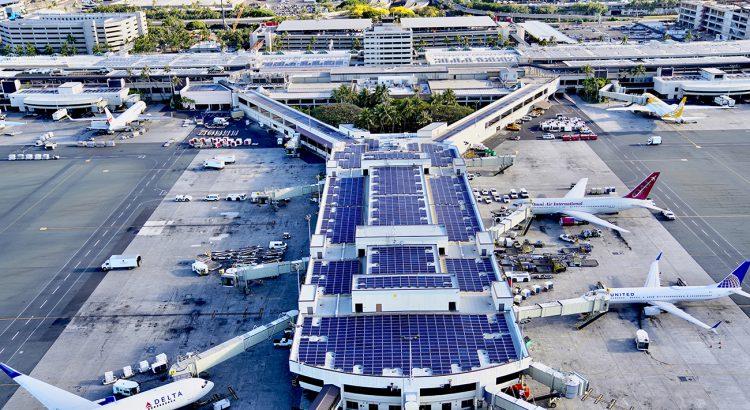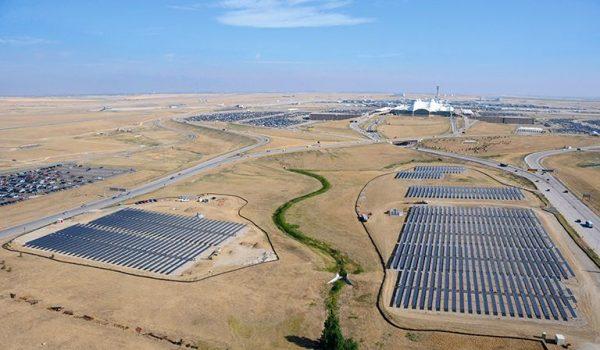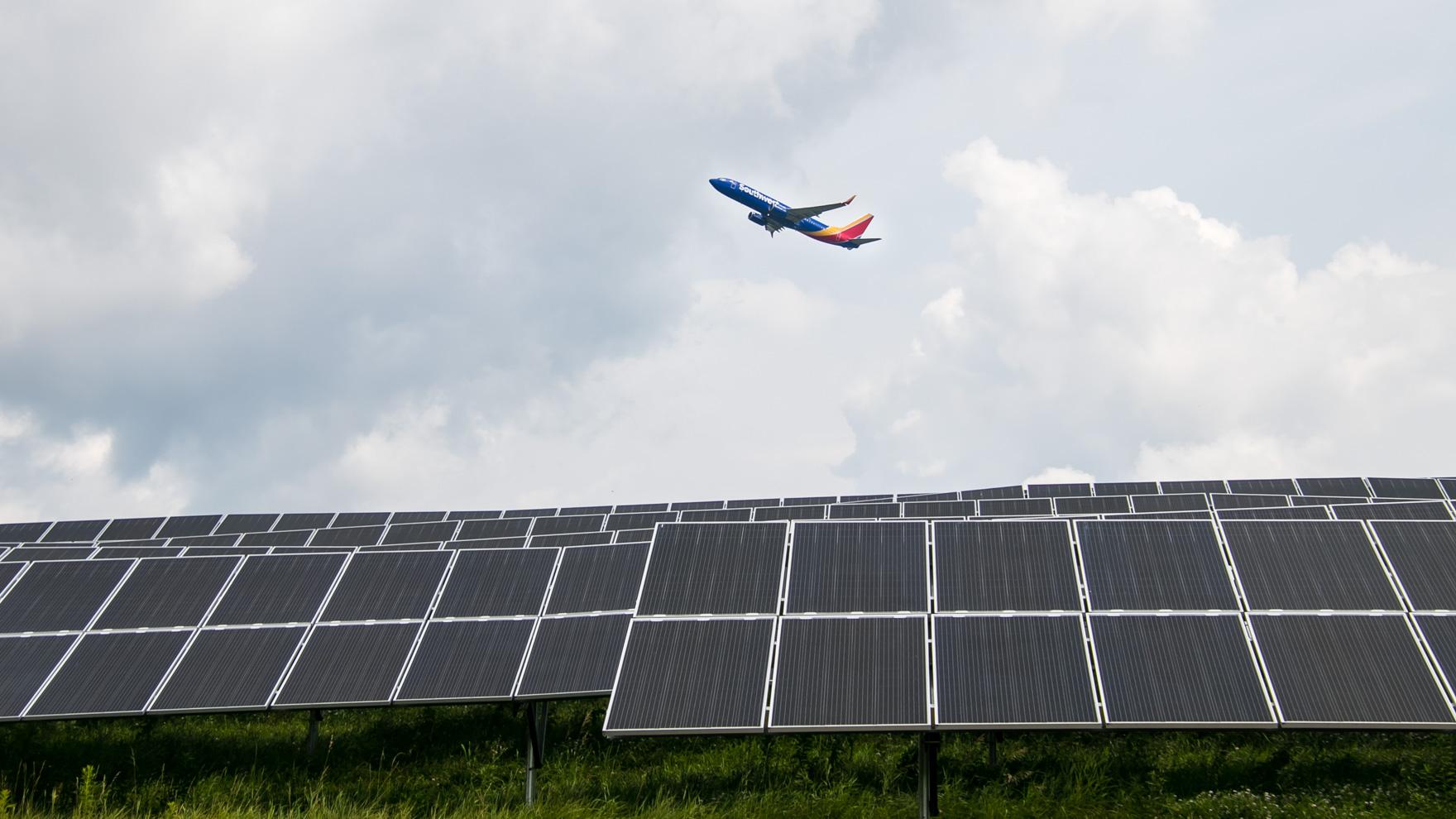The Biden Administration recently established a framework for the federal government to achieve net-zero emissions by 2050, and many state and local governments have likewise established similar plans to double down on renewables in the coming decades. The nation’s airports figure to play a prominent role in such efforts, and more and more airport authorities are embracing their promising solar power generation capabilities.
An Ideal Fit
The basics of finding an ideal site for optimal solar energy production are quite easy. Flat, expansive swaths of land are the hallmark of any large solar array. All the better if said land is minimally shaded from surrounding trees or tall buildings, thus allowing for maximum daily sunlight exposure. And lest we forget that the less landowners involved, the better. Site control is often the biggest barrier to building a solar farm, as working with multiple landowners with competing interests (and the omnipresent litigation concerns) is never fun.
This brief description sounds an awful lot like every single airport you’ve probably ever been to. Large and flat developments occupying wide open spaces without a vertical obstruction in sight. Add in the expansive rooftop surface area at airport terminals, hangars, and other buildings along with the gargantuan surface parking lots and public bus station infrastructure at airports (hello solar canopies!) and the opportunities for solar production should make any solar developer salivate.
Denver, Austin Airports Rise Above
According to a 2020 study conducted last year by the University of Colorado, 20% of public airports in the United States have adopted solar panels in some capacity over the last decade. The home state Denver International Airport is one such airport that has emerged as a national leader in harnessing the potential of on-site solar. Since 2008, the airport has installed over 42,600 solar panels across 56 acres and they’re not done yet. Construction began earlier this fall on two more solar arrays on airport property that will bring the airport’s total solar capacity to a whopping 34 MW.
“After the two new systems are energized, the airport will have solar panels spread across over 140 acres of land, making (the airport) one of the largest hosts of solar energy at any airport in the world.”
-Scott Morrissey, Senior VP of Sustainability, Denver International Airport
Austin-Bergstrom International Airport (AUS) is another major U.S. airport being hailed as a global leader in the renewable energy space. Earlier this month, AUS was recognized as one of four airports in North America to reach carbon neutrality. The airport’s renewable energy commitments are numerous and include partnering with the local utility (Austin Energy) to expand EV charging infrastructure at the airport, and purchasing renewable energy and carbon off-sets from sustainable sources. The airport also produces its own on-site renewable power thanks to a solar project completed earlier this year. AUS installed 6,642 solar panels that also double as shaded parking for airport visitors. The solar array can produce 1.8 MW of power, and thanks to an arrangement with Austin Energy’s Community Solar Program, a portion of the energy is sent back to the grid for local residential customers to benefit from.
More Airports Big and Small Turning to Solar
The accolades for solar-friendly airports don’t stop in Denver and Austin. There are in fact numerous examples throughout the country of airports that are turning to solar to reduce operating expenses and to meet sustainability goals, including some unconventional names on the list.
Take Chattanooga for example. Did you know that Tennessee’s Chattanooga Metropolitan Airport was the first U.S. airport to be powered entirely by solar energy? Completed in 3 phases and measuring the size of about 16 football fields, the airport’s on-site 2.7 MW solar farm – and battery storage technology – produces enough energy to support daily operations.
This airport’s airfield will be the first in the U.S. to run completely on solar power.
Welcome to the new @ChattAirport pic.twitter.com/2d2TKCSWW1
— Bloomberg Quicktake (@Quicktake) December 9, 2018
Solar is also taking root in another off-the-beaten-path destination, notably unsunny Maine. Just this month, a 17.5 MW planned solar farm was approved at the state-operated Augusta State Airport. The ground-mounted solar array will occupy 18.4 acres of airport property and feed electricity back to the grid, offsetting the state’s electrical costs over the life of the 21-year lease with a private developer. The economics of the project are extraordinarily favorable for Maine taxpayers. State officials expect the project to generate enough electricity to effectively save Maine $6 million over 20 years.
Meanwhile, a 12.3 MW solar + storage canopy system being built over surface parking space at New York’s JFK Airport would be the state’s largest such solar project where solar energy is produced and stored in one place. Solar energy produced by the project would power the airport’s AirTrain and send discounted clean energy to the Queens power grid. Then there is Kansas City where city officials are kicking the tires on an enormous 2,000-acre solar farm that would sit on city-owned property at the airport. City officials say that the proposed 300 MW solar farm would provide enough energy to meet all of Kansas City’s energy needs.
Airports Offer Unprecedented Scale Advantage
The ‘diamond in the rough’ solar potential of global airports really comes into focus when you consider the massive efficiency gains of putting solar projects at an airport compared to residential solar developments.
Earlier this year, researchers at Australia’s Royal Melbourne Institute of Technology published a report showing the tremendous potential of solar housed at the nation’s airports. Using satellite imagery to determine optimal solar coverage, the researchers analyzed open space at Australia’s 21 airports and compared that to 17,000 residential solar panels in a town just outside of Melbourne. They determined that if solar panels were affixed to all of the open space at Australia’s 21 airports it could generate 10 times as much energy as those 17,000 residential solar panels. Solarizing all of those airports would produce enough power to power some 136,000 homes.
The energy resilience that comes with solarizing airports can also help to solve the Achilles heel of any airport…extended power outages. Suffice it to say that losing power at a major airport can lead to chaos and steep economic losses. In 2017, an extended outage at Atlanta’s Hartsfield-Jackson Airport led to the cancellation of 1,400 flights by Atlanta-based Delta Airlines, costing the carrier some $25 million. Earlier this year, Pittsburgh International Airport became the world’s first major airport to be completely powered by its own microgrid, a move clearly designed to protect against some of the aforementioned crippling effects of losing power at the airport. The hybrid 20 MW microgrid consists of just under 10,000 solar panels installed across 8 acres of airport property along with 5 natural gas generators.
The conversation about solarizing America’s airports is of course playing out amongst the much less rosy backdrop about the outsized carbon footprint of commercial air travel. Passenger air travel continues to be responsible for the fastest growth in global carbon emissions. The commercial aviation industry is barreling towards electrification, however, even if at a snail’s pace. Making progress towards global climate goals will require a transformation of all sectors of the transportation industry. The overhauling of the aviation industry and shift to solar adoption at commercial airports is a trend that we can certainly get behind.
Cover Photo Source: State Aviation Journal







